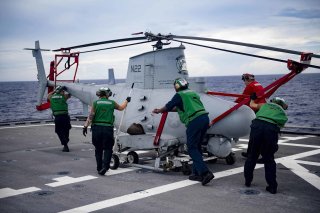The Navy's Fire Scout Drone Is Fielding a New Minehunting Pod
The Single System Multi-Mission Airborne Mine Detection pod will be the first minehunting pod used on the Fire Scout and the heaviest payload it has carried.
New sensing technologies and computer processing is expected to generate breakthroughs for the U.S. Navy’s Fire Scout drone in its minehunting mission. Improved sensors and computers will allow improve organizing speed and ensure accurate identification of targets.
The navy is prototyping and preparing new tests of a pod mounted underneath the Fire Scout. The pod is tended to analyze information from infrared sensors and relay information in real-time to human decision-makers.
The Single System Multi-Mission Airborne Mine Detection (SMAMD) program uses an “airborne sensor suite that will have the ability to have real-time onboard processing coupled with low false alarm rates will enable the warfighter to respond swiftly to detected threats,” Naval Air Systems Command said in a press release.
Faster processing at the point of collection is a critical improvement for minehunting missions and assets conducting intelligence, surveillance, and reconnaissance. Older assets might need to complete their mission and return home before data can be uploaded and analyzed. The ability to do so immediately is a significant step forward.
The press release says that the SMAMD will be the first mine countermeasure system used on the Fire Scout once it is deployed. It will also be the heaviest payload for the drone to date.
Data processing at the point of collection improves identification, while information transfer operations likely helps connect multiple domains together. In the future, minehunting Fire Scouts may be able to send information about minefields to surface ships, helicopters, and drones capable of responding and destroying mines.
If onboard computer systems included artificial intelligence (AI), detailed sensor data could be gathered, organized, and processed to assist human decision-makers. This kind of technology can give naval commanders greater awareness about mine threats and offer a larger time window with which to respond. AI-enabled processing can also assess potential countermeasures for a particular circumstance based on prior history, mine type, location, and a host of other relevant variables.
“The SMAMD will prove that a podded MCM system can operate as intended on the MQ-8C without causing adverse effects to the UAV or significantly diminishing time on station,” the press release said.
Kris Osborn is the Defense Editor for the National Interest. Osborn previously served at the Pentagon as a Highly Qualified Expert with the Office of the Assistant Secretary of the Army—Acquisition, Logistics & Technology. Osborn has also worked as an anchor and on-air military specialist at national TV networks. He has appeared as a guest military expert on Fox News, MSNBC, The Military Channel, and The History Channel. He also has a Master's Degree in Comparative Literature from Columbia University.
Image: U.S. Navy Flickr.

